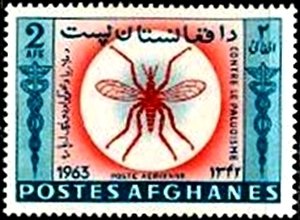Stamp: Anopheles Mosquito (Anopheles sp.) (Afghanistan 1964)
Anopheles Mosquito (Anopheles sp.) (Afghanistan 1964)
15 March (Afghanistan ) within release Eradication of Malaria goes into circulation Stamp Anopheles Mosquito (Anopheles sp.) face value 2 Afghan afghani
| Stamp Anopheles Mosquito (Anopheles sp.) in catalogues | |
|---|---|
| Michel: | Mi:AF 900A |
| Stamp Number: | Sn:AF 674D |
Stamp is square format.
Also in the issue Eradication of Malaria:
- Stamp - Anopheles Mosquito (Anopheles sp.) face value 2;
- Stamp - Anopheles Mosquito (Anopheles sp.) face value 3;
- Stamp - Spraying against Anopheles Mosquito (Anopheles sp.) face value 4;
- Stamp - Spraying against Anopheles Mosquito (Anopheles sp.) face value 5;
- Stamp - Anopheles Mosquito (Anopheles sp.) face value 10;
- Stamp - Anopheles Mosquito (Anopheles sp.) face value 2;
- Stamp - Spraying against Anopheles Mosquito (Anopheles sp.) face value 5;
- Stamp - Spraying against Anopheles Mosquito (Anopheles sp.) face value 10;
- Souvenir Sheet - Anopheles Mosquito (Anopheles sp.) face value 2;
- Souvenir Sheet - Spraying against Anopheles Mosquito (Anopheles sp.) face value 5;
- Stamp - Anopheles Mosquito (Anopheles sp.) face value 3;
- Stamp - Anopheles Mosquito (Anopheles sp.) face value 10;
- Stamp - Spraying against Anopheles Mosquito (Anopheles sp.) face value 5;
- Stamp - Anopheles Mosquito (Anopheles sp.) face value 2;
- Stamp - Spraying against Anopheles Mosquito (Anopheles sp.) face value 4;
Stamp Anopheles Mosquito (Anopheles sp.) it reflects the thematic directions:
Insects (from Latin insectum, a calque of Greek ἔντομον [éntomon], "cut into sections") are a class (Insecta) of hexapod invertebrates within the arthropod phylum that have a chitinous exoskeleton, a three-part body (head, thorax and abdomen), three pairs of jointed legs, compound eyes and one pair of antennae. They are the most diverse group of animals on the planet, including more than a million described species and representing more than half of all known living organisms. The number of extant species is estimated at between six and ten million, and potentially represent over 90% of the differing animal life forms on Earth. Insects may be found in nearly all environments, although only a small number of species reside in the oceans, a habitat dominated by another arthropod group, crustaceans. The life cycles of insects vary but most hatch from eggs. Insect growth is constrained by the inelastic exoskeleton and development involves a series of molts. The immature stages can differ from the adults in structure, habit and habitat, and can include a passive pupal stage in those groups that undergo 4-stage metamorphosis (see holometabolism). Insects that undergo 3-stage metamorphosis lack a pupal stage and adults develop through a series of nymphal stages. The higher level relationship of the Hexapoda is unclear. Fossilized insects of enormous size have been found from the Paleozoic Era, including giant dragonflies with wingspans of 55 to 70 cm (22–28 in). The most diverse insect groups appear to have coevolved with flowerin plants.
Mosquitoes, the Culicidae, are a family of small flies consisting of 3,600 species. The word mosquito (formed by mosca and diminutive -ito) is Spanish and Portuguese for little fly. Mosquitoes have a slender segmented body, one pair of wings, three pairs of long hair-like legs, and specialized, highly elongated, piercing-sucking mouthparts. All mosquitoes drink nectar from flowers; females of some species have in addition adapted to drink blood. The group diversified during the Cretaceous period. Evolutionary biologists view mosquitoes as micropredators, small animals that parasitise larger ones by drinking their blood without immediately killing them. Medical parasitologists view mosquitoes instead as vectors of disease, carrying protozoan parasites or bacterial or viral pathogens from one host to another.
Animals are multicellular, eukaryotic organisms of the kingdom Animalia (also called Metazoa). All animals are motile, meaning they can move spontaneously and independently, at some point in their lives. Their body plan eventually becomes fixed as they develop, although some undergo a process of metamorphosis later on in their lives. All animals are heterotrophs: they must ingest other organisms or their products for sustenance.



